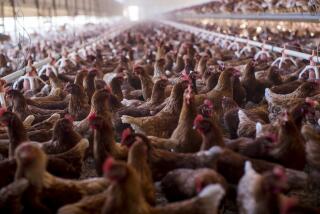Cattle’s Diet May Tame Deadly Microbe
- Share via
ALBANY, N.Y. — In the effort to keep the deadly microbe E. coli out of meat, one promising short-term tactic involves a simple change of diet.
Last year, researchers at Cornell University found that E. coli in a grain-fed cow’s digestive tract are resistant to strong acid like that in the human stomach. But when the cow’s diet was switched to hay, the bacteria became acid-sensitive, so they would die if eaten by a person.
If cattle are switched to a hay diet about five days before slaughter, E. coli in fresh feces that might contaminate the carcasses would be less likely to cause human illness, said James Russell, a USDA microbiologist and professor at Cornell.
However, once manure is outside the cow and exposed to oxygen for a while, the E. coli become acid-resistant and thus able to cause illness, no matter what the cow was fed, he said.
In studies this summer, researchers in Nebraska found that changing the diet caused a dramatic decrease in the amount of E. coli in cattle going to slaughter, said Dr. Robert Elder, a U.S. Department of Agriculture microbiologist in Clay Center, Neb.
“We found that it’s not hay, but the change from one diet to another that’s able to exclude [E. coli],” he said.
But the effect is temporary. “It just rebounds after they’re on the diet for a while,” Elder said.
Transporting cattle also causes a decrease in fecal discharge of toxic E. coli, Elder said. “That’s actually the opposite of what we expect to see in animals that are stressed.”
“Those two interventions, dietary manipulations and transport, look like the most promising short-term solutions until a vaccine or other approach comes along,” Elder said.
While those strategies might reduce the likelihood of E. coli getting into hamburger, they don’t address the problem of contamination of lakes and water supplies with runoff from manure piles.
“We’re looking at treatment technologies for manure as part of an effort to combine on-farm prevention with food processing techniques to close the loop on all the avenues by which this contamination can reach food,” said Patricia Millner, research leader of the USDA’s Soil Microbial Systems Laboratory in Beltsville, Md.
Using a process called advanced alkaline stabilization, the Beltsville researchers are mixing manure with recycled materials like gypsum, lime kiln dust and coal ash from power plants. A natural chemical reaction produces heat, ammonia and a high pH that kills microorganisms.
The research may produce a method of pasteurizing manure that’s going to be used to fertilize crops or spread on other land, Millner said. It wouldn’t prevent pollution from a temporary manure pile at a fairground.
Beef and dairy cattle produce 1.2 billion tons of manure annually in the United States. New federal regulations direct states to develop permit systems requiring waste management plans from farmers. New York was one of the first to set up a permit system this summer.






